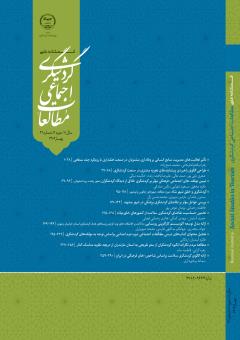طراحی الگوی راهبردی پیشایندهای تجربه مشتری در صنعت گردشگری
محورهای موضوعی : مطالعات اجتماعی و گردشگری، جامعه شناسی گردشگری
صغری تقی پور
1
,
صمد عالی
2
,
علیرضا بافنده زنده
3
![]() ,
حکیمه نیکی
4
,
حکیمه نیکی
4
1 - دانشگاه آزاد اسلامی واحد تبریز
2 - دانشگاه آزاد اسلامی واحد تبریز
3 - دانشگاه آزاد اسلامی، تبریز، ایران
4 - دانشگاه آزاد اسلامی هادیشهر
کلید واژه: تجربه گردشگري, تجربه سفر, پیشایندهای تجربه گردشگری, ويژگيهاي مقصد,
چکیده مقاله :
این تحقیق با هدف شناسایی پیشایندهای تجربه مشتری در صنعت گردشگری به روش ترکیبی انجام گرفته است. بدین منظور ابتدا در بخش کیفی به روش فرا ترکیب در بازه زمانی 2010 تا 2020، 246 مقاله داخلی و خارجی استخراج شده که پس از چندین بار غربالگری، 52 مقاله مورد بررسی محتوایی قرار گرفت و عوامل موثر بر انتخاب مقصد گردشگری شناسایی شده و با راهنمایی 10 نفر از خبرگان و متخصصان بازاریابی و گردشگری و اعمال نظر آنان پرسشنامه ای تهیه و در میان 440 نفر از گردشگران ایرانی که در پنج سال گذشته (1395-1400) به یکی از کشورهای ترکیه، مالزی، آذربایجان و امارات سفر کرده بودند توزیع گشت. در مرحله اول هريک از سازه های مدل پيشنهادي، از لحاظ تکبعدی بودن در يک مدل اندازه گيري مجزا با روش کلاین (2005) بررسی شد تا اولا، بار عاملي شاخص ها بيشتر از 5/0 باشد؛ ثانیاً ضريب همبستگي بين عامل ها بيش از 85/0 نباشد. در مرحله دوم اعتبار و روايي سازه ها مورد ارزيابي قرار گرفت و آلفای کرونباخ، اعتبار سازه (CR) و متوسط واريانس تبيين شده (AVE) و روايي سازه، روايي همگرا و روايي واگرا محاسبه شد و در نهایت مدل مربوط به پیشایندهای تجربه گردشگر استخراج گردید. نتیجه پژوهش حاضر به مدلسازی پیشایندهای تجربه گردشگر با بهره گیری از روش ترکیبی (کیفی و کمی) که از نوآوری های این تحقیق می باشد، منجر شده و مدلی متشکل از چهار مؤلفه اصلی مدیریت گردشگر، مدیریت مکان گردشگری، مدیریت منابع گردشگری و مدیریت محصول گردشگری ارائه نمود.
This study sought to identify the antecedents of customers’ experience in the tourism industry using a mixed-method approach. To this end, first, 246 domestic and foreign relevant articles published from 2010 to 2020 were collected in the qualitative phase using the meta-synthesis method, out of which 52 articles were selected and analyzed via the content analysis method. Then, a questionnaire was developed based on the results of the content analysis conducted on the articles mentioned, applying the opinions of 10 experts and specialists in marketing and tourism. The researcher-developed questionnaire was then administered to 440 Iranian tourists who had traveled to Turkey, Malaysia, Azerbaijan, and UAE over the last five years (2016-2021). On the other hand, each construct of the proposed model was examined in terms of mono-dimensionality through a separate measurement model using Kline's method (2005) to ensure that the factor loading of the indicators and the correlation coefficient between factors do not exceed 0.5 and 0.85, respectively. Then, the reliability and validity of the constructs together with the construct validity, convergent validity, and divergent validity were measured, and Cronbach's alpha, Composite Reliability (CR), and Average Variance Extracted (AVE) were calculated. Finally, the model concerning the tourist experience antecedents was developed. According to the results of the study, a model comprising of four main components, including tourist management, tourism destinations’ management, tourism resource management, and tourism product management were developed based on the antecedents of the tourist experience using a mixed method approach (which is one of the innovations of the study).
